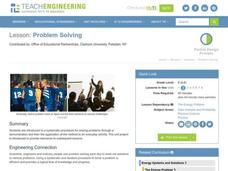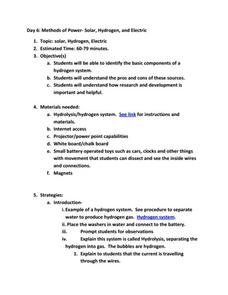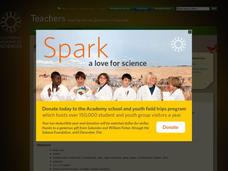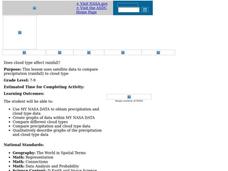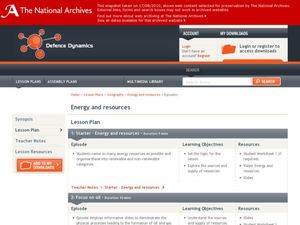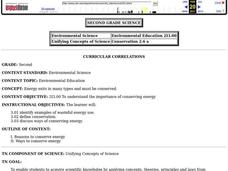Teach Engineering
Problem Solving
Need a activity? Problem solved. Scholars learn about the problem-solving process in the sixth installment of a 25-part Energy Systems and Solutions unit. The particular process in question is the Technological Method of Problem Solving.
Curated OER
Why Be Active?
Are there benefits to being physically active? Yes! There are both short-term and long-term benefits! Being physically active doesn't just have strengthen you physically, but also emotionally and socially. Learners find out how to...
Magic of Physics
Electric Circuits
Teaching about circuits can be as easy as flipping a switch! Science scholars explore the world of electricity using a fun interactive. The resource uses drag-and-drop images to promote an understanding of circuit components, types of...
Curated OER
Energy Flow and the Food Chain
Students complete discussions and worksheets about the Hawaiian food chain. In this food chain lesson plan, students research decomposers, consumers, and producers.
Curated OER
Nuclear Energy - Is it a Friend or Foe?
You can provide your students with content knowledge and hone critical thinking skills with these timely lesson plans on nuclear energy.
Curated OER
Applied Science -Physics (2B) Pre Lab
Second graders look at different types of energy. In this energy lesson, 2nd graders define energy and the difference between kinetic and potential energy. They see examples with falling books and a slinky.
Curated OER
Sun Prints
Students discuss energy and where they can find it. They will then discuss the sun and how it functions as an energy source. Next, students get a piece of black paper and some coins. They go outside and make a design with the coins on...
Curated OER
Methods of Power- Solar, Hydrogen, and Electric
Students examine solar, hydrogen, electric power. In this research based lesson, students will do simple investigations, view videos, discuss, and research how these three types of energy are used for power. They illustrate a...
California Academy of Science
Greening Your Middle School
Middle schoolers redesign their school to make it more energy efficient, and create a model of their design. Learners get together in groups of 5, and they take on the task of making their school more energy efficient. To do this, they...
Curated OER
Things That Glow: From Fireflies to Quantum Dots
Third graders observe light energy. In this heat and energy lesson, 3rd graders will study the concept of light as a form of energy. Students will examine the different forms of light and the type of energy it produces.
Curated OER
Construction of a Microscale Fuel Cell
Fuel cells are being called the "energy source" of the future. Allow your high school chemistry class to construct a miscroscale fuel cell, complete with all components to generate energy. This engaging activity will allow them to apply...
Curated OER
Do It Yourself: Matter & Energy Interaction Lesson Plan
Students complete a KWL chart describing their knowledge or renewable and nonrenewable energy sources. They examine the Stirling Engine which is an external combustion engine and compare it to a Hero's Engine. They participate in a...
Shelby County Schools
How Ecosystems Work
How does one organism get its energy? What is the main source of energy in an ecosystem? How does the flow of energy affect different types of ecosystems? Answer these questions with a fill-in-the-blank learning exercise.
Science Friday
Wind Power
Blow away the competition with a activity about wind power and turbines. Groups build windmills to test how the size of blades affect the amount of work done. The scholars build a variety of blades and collect data on how each type...
Curated OER
Home Energy Audit: Electrical Production Worksheet
In this energy production worksheet, students describe the difference between renewable and nonrenewable energy and identify the different types of energy. This worksheet has 1 short answer, 1 matching, and 1 problem to solve.
Curated OER
Harnessing Wind
Learners explore the ways that engineers study and harness the wind. They study the different kinds of winds and how to measure wind direction. In addition, students learn how air pressure creates winds and how engineers build and test...
Curated OER
Jeopardy
Power, matter, and energy sources are the subjects of this Jeopardy game. It provides a review of general science topics and expects students to know the basic details of machines, matter types, and some energy types. This...
Curated OER
Mission 7: Saving Energy
In these saving energy worksheets, students learn about energy and how to conserve it. Students complete a 22 page packet for the activity.
Curated OER
Methods of Power- Hybrids
Students list the reasons why people chose hybrid cars over traditional cars. In this technology lesson, students create a poster describing how hybrid cars work. They discuss ways to save fuel and improve a car's efficiency.
Curated OER
Does Cloud Type Affect Rainfall?
Student uses MY NASA DATA to obtain precipitation and cloud type data. They create graphs of data within MY NASA DATA. They compare different cloud types as well as precipitation types. They describe graphs of the precipitation and cloud...
Curated OER
Energy and Resources
Students identify renewable and nonrenewable resources. In this energy lesson plan, students explore the consumption issues regarding oil use and consider methods of resource management. Students research alternative resources and...
Curated OER
Thinking about Energy
Students examine their understandings about energy concepts by completing an online survey. Students participate in a class discussion about their uses of resources and the differences between perpetual, renewable, and nonrenewable...
Curated OER
Potential and Kinetic Energy
Sixth graders explore potential and kinetic energy. In this science lesson, 6th graders assume the role of a roller coaster engineer and design a roller coaster. Students use their knowledge of kinetic and potential energy to design a...
Curated OER
Energy Conservation
Class is divided into groups of 2-4 students. They then are given a list of 36 items that are found in our homes and which use electricity. They are going to pretend that because of an energy shortage, they have to pick only twelve items...


